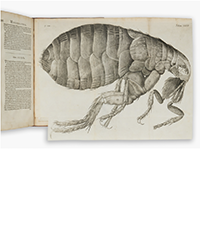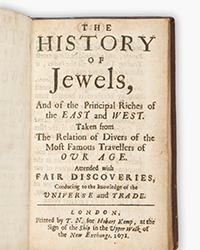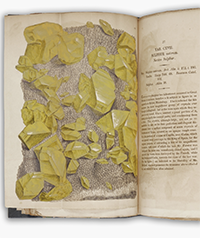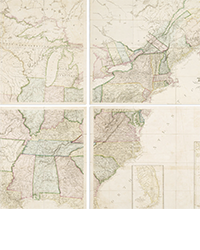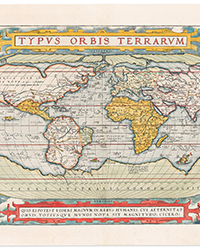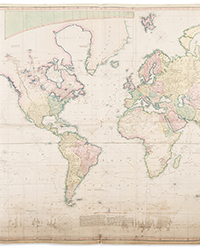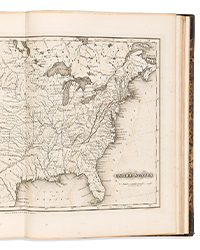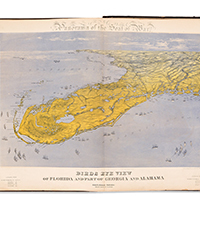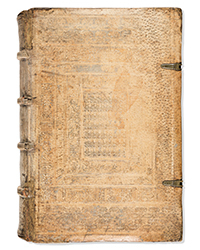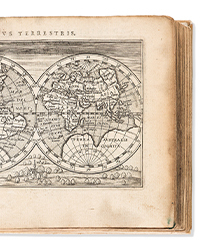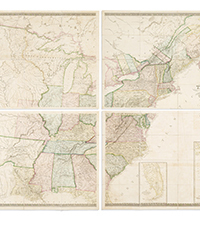I asked leaders in the auction field for their perspective on the year that was, the year that will be. Here are responses in alphabetical order by Catherine Williamson of Bonhams, Christina Geiger of Christies, Stephan Ludwig of Forum Auctions, Selby Kiffer on behalf of Sotheby’s and Nicholas Lowry on behalf of Swann Galleries.
Catherine Williamson - Bonhams
Here are my thoughts:
When the original shelter-in-place order was issued in late March, we were terrified, not just of the virus, but of how we would keep our business afloat. We were in the final month of property-getting for our important June sales, and nearly all consignment activities were tabled. Then almost half my staff was furloughed. With a smaller team and less property, the Bonhams Book Department had to figure out how to convert a traditional auction to an online-only format, which we had only done in a limited way to that point.
We were more prepared for the limitations brought on by the pandemic than we thought, however. In February, I was writing a proposal for a client who was already terrified of COVID-19, and worried that the spread of the virus would limit travel and affect our sales (how right she was). In order to address her fears, I did some research and produced a graph showing the percentage of book buyers who participated remotely in our sales to that point (either by absentee, phone, or internet), and the number that emerged was an astonishingly high 85%. Before COVID. When you think about it, it makes sense: antiquarian catalog sales are the original remote purchasing experience, and the book trade was one of the first to embrace the opportunities of the internet. The book community actually was prepared for a global pandemic.
Since we already had a high percentage of buyers who did not need to be in the room to bid at an auction, and since a great percentage of those people enjoyed a strong computer literacy, we just had to transition our auctions to online-only, and make sure buyers were aware of the new format for our June sales. There were a few luddites who resisted the new format, but not very many.
One important innovation at Bonhams was the development of the “live-hybrid” sale, which is an auction that functions traditionally with a live auctioneer, clerk, and phone bidders, but which has only the first two in the auction room while the phone bidders are looped in remotely. The “live-hybrid” format captures the excitement of competition that is the life blood of a traditional auction, in a socially distant manner. We were the first international house to introduce this technology, and it has worked remarkably well for us since the spring.
By the end of 2020, my team was back and we were holding auctions that were not only full of great property, they were selling remarkably well. (One plus for sellers during COVID: many of our buyers are stuck at home in front of a computer, maybe with a little more spending money thanks to limited entertainment spends.) Now that we have our sea legs, we’re looking forward to a strong 2021, with several great single-owner sales already in the kitty. Who would have thought?
What’s changed for our world? For one, the online-only format is here to stay. Its advantages are now clear to us all. For buyers, the pressure of getting a bid in during the period when the lot opens and closes is greatly reduced when a lot is open for two full weeks. For the auction houses, we appreciate that we can take in property literally up to the last minute before a sale goes live. Amazing!
Other traditional sale timeline windows are shrinking. The long-lead for press coverage and marketing has grown shorter, because so much less of our outreach is through traditional printed venues. An advertisement in a digital publication does not have to be submitted six weeks before the publication date. If you get it in two weeks early, you are a star. And of course, social media has taken on a bigger responsibility for sale promotion, which means the department itself gets to decide which items we promote, and can shape our campaign based on early interest from buyers.
Finally, we probably will not return full-time to the office. I miss my office-mates—the Prints specialist across the way and the Native American specialist who sat next to me. I miss the collaboration that arises when you ask someone from a different specialty area about a puzzling item. But much of what we do can be done from home, which (when my kids are not in class in the next room) will be a quieter and more productive environment.
Finally, I have grown closer to my book department colleagues from our regular zoom meetings (where I actually see the NY and SF teams, instead of just hearing their voices), and from surviving a harrowing year of twists and surprises. For that, and for our continued good health, I am very thankful.
Catherine Williamson, Ph.D.
Director, Fine Books & Manuscripts
Bonhams
Christina Geiger - Christies
A Look Ahead, from Christie’s New York Books & Manuscripts
Although 2020 was not without its bright spots, I'm excited to turn the page and start a New Year. Like all auction houses, we had to adapt in 2020 to selling books without gathering to see items and raise paddles in person. With about 250 lots selling in January, 100 of them live and 150 online, 2021 already looks very different from the previous year. Although we offered just one lot by live auction in 2020, it was one for the record books: Shakespeare’s First Folio of 1623, accompanied by a letter from Edmond Malone attesting to the genuineness and cleanness of this very copy. It was the first complete First Folio to be sold at auction in almost 20 years and set a world record for a work of printed literature at just shy of $10 million. By contrast, all of our other auctions were held online-only, with only virtual viewings in the spring and virtual and by-appointment viewings in the autumn. The winter and spring sales this year will likely continue as appointment-only, but we are very eager to open our doors more widely at Rockefeller Center as soon as it is safe to do so.
The success of the online platform for various-owner book auctions in 2020 was remarkable and we will continue to use this platform for all currently scheduled various-owner sales in 2021. We are still printing auction catalogues of the same size and quality, but in lower print runs and more selectively; and there is greater emphasis on new tools of digital marketing. However, it was probably not only the marketing and the time on their hands that attracted scores of new clients to bid in online sales. The perception of greater flexibility and transparency is also attractive. These sales were “open books” where the listed starting prices are identical to the reserves. And it was not only modern works for Led Zeppelin or by Virginia Woolf which exceled online, but also rare and early American imprints, Audubon, and even incunabula.
Increased online auctions are not the only adaptation to the pandemic which will endure in the months and years ahead. The global possibilities of digital events have been eye-popping. For the first time we livestreamed an event on a WeChat Mini Program; it featured Shakespeare’s First Folio, with the book and specialist in New York and the moderator and panelists in Beijing. We expanded collaborations on events, including with the Battery in San Francisco, the Princeton Club, the New Antiquarians, RBMS, and Atlas Obscura. The webinar “Book Collecting in the Digital Age” featuring Rhiannon Knol and Michael Diaz-Griffith of the Soane Foundation is currently viewable. The long shelf life of our programs is something we appreciate.
Lastly, the pandemic itself was not the only important instigator of long-lasting change in our business. 2021 will be a year to get serious about lessening our environmental impact. I adore a printed auction catalogue and the layout and design process is one of my all-time favorite parts of my job. However, even I recognize that print runs in the thousands don’t make environmental or commercial sense. And, while there was some business that was postponed last year because specialists were not flying around to see books and clients, we found creative workarounds for the large majority of both consignment-getting and selling. Less frequent jet travel conserves the environment and saves valuable specialist time; I hope it’s here to stay. Another New Year’s resolution for the department will be to incorporate more contemporary scholarship into our cataloguing. The large majority of references we cite—particularly for printed Americana and travel books—were written many decades ago and can be rife with prejudice and omissions. Supplementing our reference library with more works by contemporary historians, even if not bibliographies, is a small but important step. It is gratifying to see the central role of history in current discussions of social justice and I believe our business has a part to play. To that end, I’ll also take the opportunity to support the outstanding virtual program put together by our friends at the Bibliographical Society of America. The Annual Meeting is on Friday, January 29 with the keynote address on the crucial theme of “Liberation Bibliography.” All BSA events are free and open to the public. I hope to “see” you there.
Best wishes for a peaceful and prosperous 2021!
Christina Geiger
Stephan Ludwig – Forum Auctions
“The past 9 months have been characterized by a once-in-a-generation change to the manner in which the auction market operates. By necessity our industry has had to transform overnight into an ‘online only’ marketplace and adopt new practices that afford buyers across all verticals the confidence to bid for unseen material and rely on purchased goods being delivered within reasonable timeframes.
Many commentators have of course been predicting the evolution from bricks-and-mortar live auctions to a ‘bricks-and-clicks’ paradigm for some years, though even the most adventurous were putting timeframes of 5-plus years on the the quantum shift to digital auctioneering becoming the norm as opposed to the exception. It is quite literally unbelievable, and a ringing endorsement of the creativity living within a historically unadventurous industry that such a shift has occurred within the course of less than a year.
Forum Auctions launched in the summer of 2016 with the USP of being e-commerce focussed, aspiring to be at the vanguard of what it’s founders considered to be an inevitable path of travel for the industry. Back in 2017 we announced with pride that over the course of our first full year of trading more than 50% of sold lots were transacted exclusively online. Fast forward to 2019, and the predominance of our fortnightly timed online auctions had pushed this statistic to over 80%. However, behind these headline numbers sat the reality that more than 50% in hammer value continued to be generated by our bi-monthly live auctions.
2020 has been an extraordinary year for us; having harnessed the potential behind our online-only sales format we found no resistance from our vendors to push what would hitherto have been live auction material onto the web and sellers were rewarded with higher than ever sell-through rates and realisations. Indeed, over the course of the year, our selling rate has remained above 90% of lots offered and hammer prices have consistently delivered realisations above mid estimate. Most pleasingly, collectors greeted our single owner sales from the Birmingham Assay and Rugby School libraries with unfinished fervour.
As the year draws to a close we are proud to have sold over 10,000 lots realising a premium inclusive £20,000,000, selling more 6-figure lots than ever before. Most importantly we have attracted over 2,500 first time auction clients who together with Forum regulars consistently express their satisfaction at the service and results delivered by our small 18 person company.
Whilst best known for the considerable breadth of our specialists’ books knowledge, Forum’s team has also carved out a market leading position in the market for British street artist Banksy’s numbered editions. Having held the first ever single artist auction for Banksy’s material in October 2016 Forum continues to sell over 1 in 4 of the artist’s numbered and signed prints offered at auction worldwide. Translated into numbers, in 2020 we sold 113 of the 400-odd works auctioned globally, outselling every other auction house in this sector. (Source artnet)
And what of the changes in market practice.....first and foremost, an enduring impact of the COVID-driven changes to auction practices is the marked improvement in post-sale buyer services. Historically it was not uncommon for the successful bidder having to work harder than the auction house to receive their goods at home. There should be no retrograde slippage away from the e-commerce ‘Amazon style’ fulfilment practices our clients have learned to enjoy over the course of the year. Secondly, whilst we of course anticipate a return of the live auction I suspect such offerings will become considerably more selective and collectors will no doubt appreciate the ‘Fine and Important’ preface to auction titles becoming a more apposite adjective!
All things considered, 2020 has been a surprisingly robust year for the performance of most collecting categories with government-generated liquidity and varying incarnations of staff furloughing taking the immediate sting out of the collapse in broader economic activity. We enter 2021 with a measure of apprehension as the inevitable reality of reduced personal spending and heightened economic uncertainty is likely to take the shine off some of those segments that have seen particularly large price rises in 2020. Irrespective of the waxing and waning of global GDP, it is unrealistic to anticipate a continuation of 2020’s unique phenomena that afforded the habitually ‘cash rich and time poor’ more down-time and increased bandwidth to focus on collecting.
I am seeing in the new year with unqualified gratitude for having survived 2020 alongside respectful caution in formulating strategies for steering Forum and our dedicated staff through the coming 12 months in what will be our 5th anniversary year.”
I hope you and your family are having an agreeable holiday period.
Best
Stephan
Stephan Ludwig
CEO
Forum Auctions Ltd & BFW 2018 Ltd
Tel: + 44 (0) 7917 603202
Selby Kiffer - Sothebys
2020 was an undeniably difficult and challenging year for auction houses, Sotheby’s included. But from the perspective of thirty-seven years in Sotheby’s Books and Manuscripts Department, it was not the most difficult year we have experienced. (This last observation is not meant in any way to diminish the monumental impact on the world’s economies and health wrought by Covid-19 and the response to it.)
Auctions continued and in fact increased in number. Globally our New York, London, and Paris departments held some twenty-five sales, almost all of them occurring post-pandemic. Books and Manuscripts also contributed to a number of interdisciplinary auctions throughout the years, notably “Alfred Stieglitz, Georgia O’Keeffe, Juan Hamilton: Passage.” The 2020 auctions were different in some ways from sales in previous years, but it should be acknowledged that many of these changes—especially the move from auction rooms to online bidding platforms—were accelerated by Covid-19, not initiated by it. First telephone bidding and, later, online bidding had already diminished attendance at many live sales, and exclusively online auctions were the logical next step. At Sotheby’s New York we held our first solely online Books and Manuscripts auction in 2018. I freely admit that I was a sceptic at first, but having seen their success and advantages, I am now a proponent. But I also believe there will always be a role for live auctions for particularly significant and distinguished properties, as demonstrated by our commitment to holding a live auction, with full pre-sale exhibition, in April 2021 of the Printed and Manuscript Americana from the Collection of Barbara and Ira Lipman.
I’m less sanguine about another looming auction change that was hastened by Covid-19, which is the deemphasis, if not elimination, of printed catalogues. I believe this is a special point of contention for those who collect and work in the realm of the written and printed word, but I don’t believe this adaptation is welcomed by any collecting area. While printed catalogues will continue to be produced for especially noteworthy collections (again, like the Lipman Americana), catalogues for more routine auctions are also valuable reference works and provide a handy medium for commentary and annotation. At the least, auction houses should make their past online catalogues fully available in an easily searchable archive, complete with unsold lots and any post-publication emendations. At best, they will provide online cataloguing in a clean, printable format so that bidders and other clients can continue a useful run of catalogues, should they so desire.
Perhaps the greatest advantage of online auctions is that they can be moved from consignment to sale very quickly. They also allow us to handle as discreet auctions smaller properties that in the past would have been combined with properties from other consignments to reach a total value that would justify holding a live sale. So in mid-November we were able to present as a single-owner sale, “Dada Data: Books and Boîtes by Marcel Duchamp and Others,” just twenty-nine lots from the Collection of Carlos Alberto Cruz, which achieved almost half a million dollars. Because of this new flexibility, I believe that the old model of a fixed sale calendar, with major sales always taking place in the same few months, year after year, is a thing of the past. There is also a coming cohort of collectors who never experienced—and so cannot miss—the spectacle of a major evening sale of Books and Manuscripts. They have grown up with smart phones and are already comfortable with the virtual world that was intruded into the books and manuscripts world in 2020. These collectors will eagerly support online auctions and encourage the field to expand into new areas, as we did in September with the first—and highly successful—auction dedicated to Hip Hop at a major international auction house.
On a human level, 2020 brought a lack of personal engagement with colleagues, even in my department, let alone the wider bibliographical world. I haven’t seen two booksellers or book collectors in the same room since the first week of March. That I trust will not last too long into 2021. But to end on a positive note, the pandemic showed that many of us could work efficiently and effectively from home—at least part of the time. That is a trend I would like to see continue into the future.
I’m not going to try to predict the new normal. Will the future be any more different than pre-pandemic 2020 was from the time I began at Sotheby’s?: Cataloguing on a typewriter; correcting proofs sent by a printer; marking glossy black-and-whites with a grease pencil and sizing wheel; receiving estimate requests and other inquiries in the mail (sometimes with Polaroid photos enclosed!) or on the telephone; paging through twenty volumes of American Book Prices Current to track the value of a book.
Whatever the changes, there will be, I believe, one group of persons wishing to sell books, manuscripts, and associated artifacts, and another group wishing to purchase them—and auction houses eager to help facilitate the exchange. As Carl Van Doren observed, “The future will never be futuristic. It will be like the present, only more so.”
Selby Kiffer
International Senior Specialist
Books & Manuscripts
Sotheby’s
Nicholas D. Lowry – Swann Galleries
View From the Podium: Year’s End, 2020
Long before December, 2020 had already become a year everyone was looking forward to forgetting. Civilization as we recognize it was put on hold. We entered an enforced hibernation that affected the way we ate, shopped, worked, communicated and socialized. Travel became a luxury of the past, as did school, vacations, dinner parties, and cocktails with friends. Daily life was turned upside down as our lives were endangered by the spreading virus.
Milestones came and went in unremarkable ways. Birthdays, anniversaries, weddings, reunions, holidays, celebrations and even, sadly, funerals were delayed, digitized or put on hold. Old familiar habits were surrendered and in their place new habits have already formed. The “new normal” is no longer new—it has become routine. Yet through it all there were so many bright spots that risk being lost in the tedium of Zoom meetings, working from home, quarantining and isolation.
The brightest of which, in my opinion, is how as a team Swann rose to meet new challenges, and then managed to turn one of the grimmest of years into a successful one. We all kept our focus on doing our jobs as best we could under changed circumstances, and we were rewarded with impressive results. Since the shut down in March we have catalogued and held 23 auctions; we launched a new department; records were set across the board in all different areas of expertise; new specialists held premiere auctions in their individual categories. Throughout it all Swann’s esprit de corps held up.
2021 holds a lot of exciting news for Swann. We will hold new auctions in previously untapped categories (like our Artists of the WPA sale, slated for February 4), we will be unveiling our new digital imprint—an immersive online reading format designed to combine the best of the old school auction catalogue experience with 21st century design and sensibility. In August, we will be holding our third auction dedicated to LGBTQ+ art and history.
Whatever the New Year brings, I am confident, from seeing our great team in action, that Swann will persevere and continue to bring wonderful material to market and be able to continue serving our collecting community.
The thing about being an auctioneer is that you are always looking out into the crowd in front of you. Podiums don’t have rearview mirrors. But looking back, this past year I see so much to be thankful for—our colleagues, our collectors, our city, our community. And I never want to lose sight of that.
With my gratitude and kindest regards for a peaceful, healthy and mindful New Year,
Nicho
Nicholas D. Lowry
President & Principal Auctioneer
Go to Part III - The Dealer Perspective + Marvin Getman.



![<b>Sotheby’s, Dec. 11:</b> Darwin and Wallace. On the Tendency of Species to form Varieties..., [in:] <i>Journal of the Proceedings of the Linnean Society,</i> Vol. III, No. 9., 1858, Darwin announces the theory of natural selection. £100,000 to £150,000. <b>Sotheby’s, Dec. 11:</b> Darwin and Wallace. On the Tendency of Species to form Varieties..., [in:] <i>Journal of the Proceedings of the Linnean Society,</i> Vol. III, No. 9., 1858, Darwin announces the theory of natural selection. £100,000 to £150,000.](https://ae-files.s3.amazonaws.com/AdvertisementPhotos/00d5fd41-2542-4a80-b119-4886d4b9925f.png)


